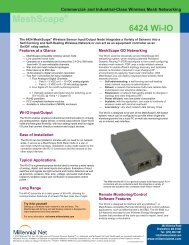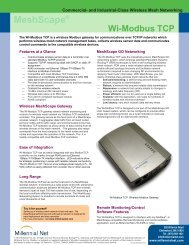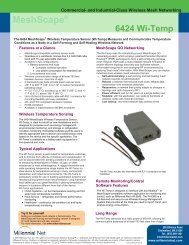Self Powered Ad-Hoc Networks (SPAN) Perpetually ... - Millennial Net
Self Powered Ad-Hoc Networks (SPAN) Perpetually ... - Millennial Net
Self Powered Ad-Hoc Networks (SPAN) Perpetually ... - Millennial Net
You also want an ePaper? Increase the reach of your titles
YUMPU automatically turns print PDFs into web optimized ePapers that Google loves.
<strong>Self</strong> <strong>Powered</strong> <strong>Ad</strong>-<strong>Hoc</strong> <strong><strong>Net</strong>works</strong> (<strong>SPAN</strong>)<br />
<strong>Perpetually</strong> <strong>Powered</strong> Unattended Ground Sensors<br />
Overview<br />
Lockheed Martin has developed a perpetually powered, mesh<br />
sensor networking and data exfiltration system known as<br />
<strong>SPAN</strong> (<strong>Self</strong> <strong>Powered</strong> <strong>Ad</strong>-<strong>Hoc</strong> <strong><strong>Net</strong>works</strong>) to advance the area<br />
of Reconnaissance, Surveillance, Exploitation and Intrusion<br />
Detection. <strong>SPAN</strong> is designed for users who require quick<br />
deployment, low probability of intercept (LPI), and reliable and<br />
persistent surveillance.<br />
<strong>SPAN</strong> provides wireless sensor detection ranges of tens of<br />
meters and communication ranges of hundreds of meters. The<br />
system implements recent advances in micro energy storage<br />
and energy harvesting technologies to eliminate existing power<br />
issues, while drastically reducing node size and weight (sensor<br />
nodes on the order of 2-3 cubic inches and 6-8 ounces).<br />
Technical & Operational Approach<br />
The key discriminators and advantages of the <strong>SPAN</strong> system when compared to existing UGS systems can be described in the<br />
following domains: size and weight, power, sensor networking, data exfiltration, and system usability. The Lockheed Martin approach<br />
has focused on advancing the UGS system in each of these areas to create an overall design that is more flexible, beneficial, and<br />
reliable to the user.<br />
Size & Weight<br />
By incorporating state-of-the-art technologies, the <strong>SPAN</strong><br />
system consists of palm-sized, lightweight sensor nodes.<br />
<strong>SPAN</strong> nodes have been disguised as natural features, such as<br />
rocks, to address the covert nature of deployments by users.<br />
The robust packaging allows the <strong>SPAN</strong> sensors to withstand<br />
heat, water and other harsh environmental conditions. The<br />
covert packaging design was developed along with the various<br />
other power and exfil methods that ultimately factor into a<br />
system with very low LPI/LPD.<br />
Power<br />
The <strong>SPAN</strong> sensor nodes use thin-film energy storage cells coupled with solar and thermal energy harvesting devices to provide<br />
truly perpetual power. Intelligent mesh networking management techniques lower power consumption by minimizing wireless<br />
communications and distributing data processing. <strong>SPAN</strong> uses dynamic reconfiguration of wireless communication pathways to reduce<br />
data re-transmission rates and save power. Real-time power monitoring and adaptive duty cycling enable optimal energy budgeting.<br />
These advances in energy management will enable troops to infiltrate areas with a covert, low-maintenance sensor net, capable of<br />
persistent surveillance and alert reporting.<br />
<strong>Net</strong>work and Data Exfiltration<br />
The <strong>SPAN</strong> system leverages a mesh networking approach that enables sensor nodes to join and leave the network in an ad-hoc fashion.<br />
All network configuration is automatically handled by gateway nodes. The network protocol has been tested and proven to allow for<br />
scalability to hundreds of nodes to address various deployment needs. This network of sensors approach allows the <strong>SPAN</strong> system to<br />
take advantage of multi-sensor data fusion and sensor queuing to balance probability of detection and low probability of false alarms.<br />
Transmitted alert data from all of the sensor mesh nodes is then processed by fusion and correlation algorithms on the gateway nodes.<br />
The output alerts from the gateway nodes are used to alert the end user to intrusions, perimeter breaches, and characterize enemy<br />
movements.<br />
System Usability<br />
The <strong>SPAN</strong> system was designed with efficiency and ease of use as primary<br />
objectives. The domains discussed thus far including power, networking and data<br />
exfil were all developed around the central objective of creating a system that is<br />
quickly deployable and efficiently usable by the end user. The end user interacts<br />
with the system via a handheld application which was developed to provide<br />
seamless portability between the various handheld manufacturers. Features include<br />
map displays, state of health displays, sensor alert displays, query capabilities,<br />
sensor processing parameter configuration, and platform GPS integration.<br />
© 2010 Lockheed Martin. All Rights Reserved.<br />
Lockheed Martin<br />
Information Systems & Global Solutions<br />
Lawrence Delp<br />
P.O. Box 8048<br />
Philadelphia, PA 19101<br />
610-531-1695<br />
www.lockheedmartin.com









